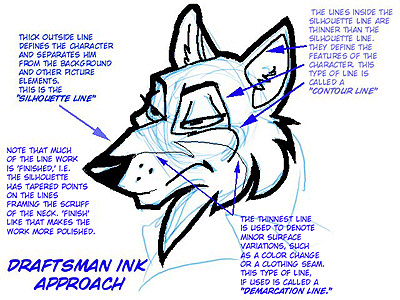 back |
 home |
 next |
The two broad categories of inking style can be classed as "draftsman" and "painterly." Experiment with different styles if you can. Generally what happens is a person will find a type of inking they can do well, and stick with it. I have found it advantageous to know more than one style of inking. We'll discuss draftsman-style inking first, as it is the easiest of the styles to do, and will give your drawings more punch, or visual impact. While the line thicknesses are exaggerated in the following examples (in order to make the differences in line strength apparent), a bold line does have its advantages. As an example, note the graphic punch of "The Powerpuff Girls."
Below is an example of draftsman-style inking. To make draftsman-style inks work you simply need to find two pens you like, which have noticeably different thicknesses. In the past I've used Technical Rapidographs for this, with successful results.
 Click for original art |
The example shows a "three line" approach to inking. The silhouette of the character is enclosed in the heaviest line, aptly called "the silhouette line." The next thickest line is called the contour line, as it delineates the character's features and shape within the silhouette. The thinnest line is called the "demarcation line." It is used either to mark the boundaries between color changes, or thin seams.
Modifications of this style use many different 'groupings' of line thicknesses, so that each of these groups can be used to portray characters at various distances from the picture plane. Point of view is that of the viewer / camera. Lines which are emphasizing objects moving past the POV (point of view) can follow or highlight the perspective of the moving object the same way the shape of the moving object does.
| this tutorial | ||||
 back |
 home |
 next |
||
| Tutorials | ||||
 back |
 Home Page |
 next |
||
